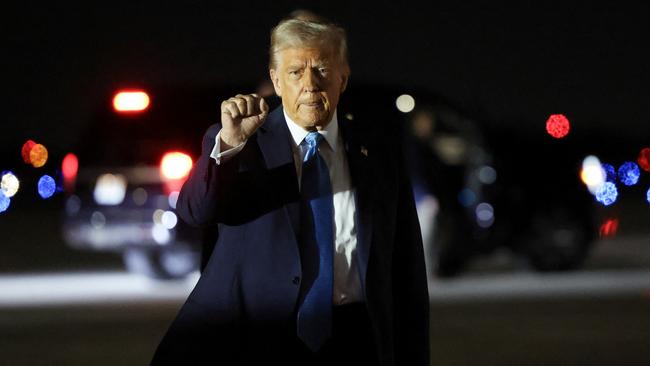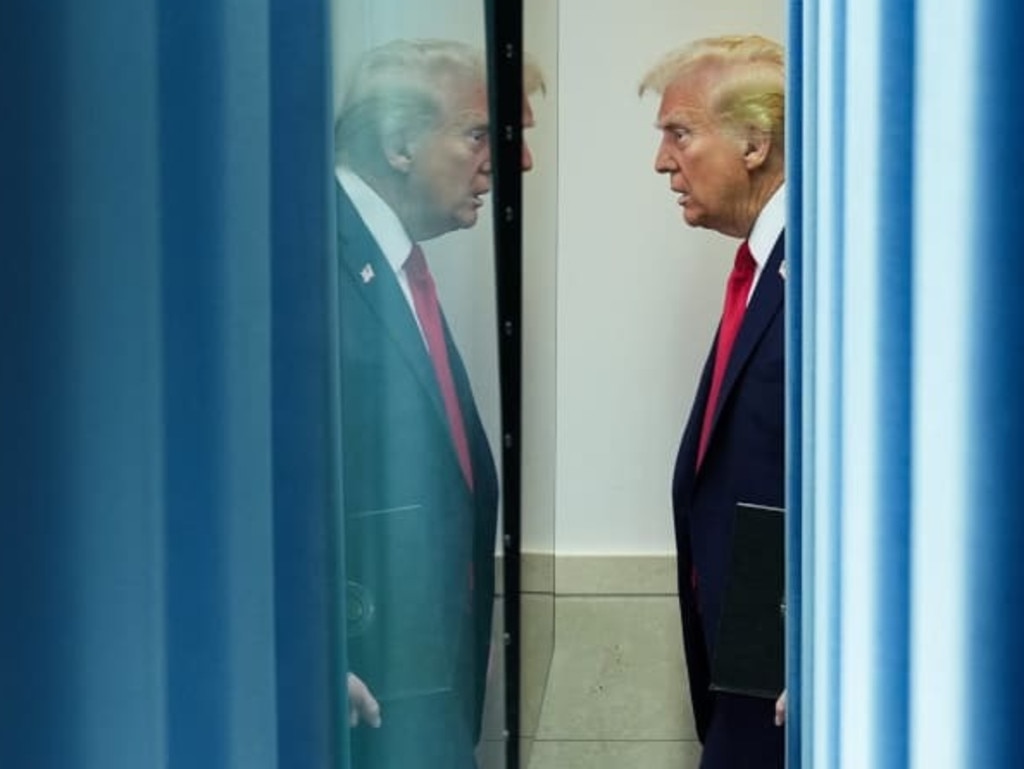Trump’s tariffs usher in new trade wars. The ultimate goal remains unclear
The President’s trade assault, which makes no distinction between ally and adversary, is an assertion of US dominance with significant risks.

Until the moment when President Trump announced 25 per cent near-universal tariffs on Canada and Mexico, many on Wall Street, in Washington and in foreign capitals doubted he would. They didn’t see how the changes served the US economic, political or strategic interest.
That Trump did so anyway shows just how profoundly he is rewriting the source code of US economic relations. The post-war bipartisan consensus that the US prospers by fostering co-operation and integration with allies and neighbours is gone. In its place looms the prospect of continuous trade war driven not by traditional alliances and ideology, but the priorities of the day. The winner is the one who can inflict, and withstand, the most economic pain.
What comes next is highly uncertain because Trump’s motives are difficult to discern. He justified the tariffs, plus a 10 per cent tariff on China, as a way to stop the flow of fentanyl and illegal migrants. Howard Lutnick, Trump’s commerce-secretary nominee, last week said Canada and Mexico were acting swiftly on those concerns, implying a resolution could come quickly. The tariffs are to take effect on Tuesday.
Yet negotiators from both countries reportedly have struggled to figure out what would satisfy Trump. His officials have set vague-enough conditions that could justify tariffs indefinitely. Even if the tariffs announced on Saturday are modified or removed, Trump can reimpose them at any time, and he is still considering broad tariffs on the entire world. Drugs and migrants might turn out to be a pretext for bigger, long-term goals. Trump claims tariffs will usher in a “golden age” akin to the late 1800s. He sees them as not just a source of revenue and protection, but a sort of financial gunboat diplomacy that could force Canada to submit to annexation and Denmark to surrender Greenland.
“Will there be some pain? Yes, maybe (and maybe not!). But we will make America great again, and it will all be worth the price,” Trump wrote on social media Sunday. Philip Verleger, a longtime energy analyst, writes in a forthcoming article that Trump “intends to ‘Make America Great Again’ … by diminishing the power of every other country. Co-operation is not an objective. His focus is dominance.”
This trade war isn’t like the last
While Trump hit many countries in his first term, China was the focus. Most of the annual $US380bn ($623bn) of imports subjected to tariffs were from China, notes Erica York of the Tax Foundation. By contrast, York estimates Trump’s latest tariffs will hit about $US1.4 trillion of imports annually – mostly from US allies.
His first administration was thick with foreign-policy hawks such as vice president Mike Pence and national security adviser H.R. McMaster, who thought tariffs on China complemented the mission of containing a geopolitical adversary. Trade ambassador Robert Lighthizer, the architect of Trump’s first-term tariffs, put China in a category of its own.
Trump’s second-term actions make little distinction between adversaries and allies. He threatened tariffs against Colombia, a close economic and security partner, over its initial refusal to take back deported migrants. Then he sent an envoy to Venezuela, a longtime US antagonist, to negotiate the return of migrants and the release of detainees.

In Trump’s first term, tariffs were levied using laws with narrowly prescribed conditions that allowed affected companies and individuals to weigh in and prepare. This time, Trump acted within weeks of taking office before his own commerce secretary or trade ambassador were in place.
He used a statute, the International Emergency Economic Powers Act, usually reserved for terrorists and rogue states. It imposes almost no waiting period, is unusually broad and is difficult for congress or the courts to block. It effectively allows Trump to wage economic war with virtually no notice, oversight or expiration date.
The trade wars of his first term were mostly about trade. Trump used the threat of tariffs to persuade Canada, Mexico, Japan and South Korea to amend existing trade agreements that he thought unfair and the source of trade deficits.
He has since added two goals. He has said the revenue from tariffs can pay for lower income taxes, which implies he intends them to be permanently higher.
And Trump is treating tariffs as an all-purpose tool to achieve a range of economic, political and strategic goals. “Previous administrations have failed to leverage America’s combination of exceptional strength and its unique role in world trade to advance the security interests of the American people,” the White House said on Saturday. “President Trump has not.”
There will be costs – short and long-term
On Friday, anticipation of tariffs caused stocks to plunge and bond yields to edge higher, because investors expect tariffs to be stagflationary, hurting growth and raising prices. Goldman Sachs estimates the tariffs on Canada and Mexico, if sustained, would add 0.7 per cent to consumer prices and knock 0.4 per cent off economic output. (The lower 10 per cent tariff on Canadian energy would mitigate that.) Meanwhile, Mexico and Canada could fall into recession.
With time, economies adapt to shocks such as tariffs. Their employment recovers, but they end up poorer as goods that were once imported from the most efficient source are now produced domestically or further afield. They change their buying patterns to adapt. In 2019, Deutsche Bank estimated a 25 per cent tariff on Mexico would raise the average new-vehicle price in the US by $US1,300 and reduce annual sales by 18 per cent, or three million units.
Long ago multinationals served the US and Canadian markets separately, from local plants. With the Canada-US free-trade agreement in 1988, localisation gave way to globalisation with plants in both countries serving the continental and sometimes global market.
Once companies accept tariffs as permanent, globalisation will likely give way to localisation again. On Saturday, Prime Minister Justin Trudeau urged Canadians to check the labels in supermarkets and favour Canadian-made products, and to vacation in Canada (a decision made easier by the lower dollar).
The US imports most of its potash, essential for fertiliser, from Canada, the world’s largest producer. Australian mining company BHP plans to start production at a new potash mine in Saskatchewan next year. If exports to the US are uneconomic because of tariffs, they would likely go to other markets, such as Brazil, says Ragnar Udd, the company’s chief commercial officer. The US would presumably import more from Russia and Belarus, two of the next-largest producers, he says.
Then there are the political ramifications. Trump seems to be betting that Mexico and Canada have too much to lose from letting the trade war escalate or diplomatic and security relations, such as over the southern border, to suffer. He has urged Canada to become the 51st state to avoid the pain of tariffs.
But Michael Froman, a former trade ambassador under president Obama and now president of the Council on Foreign Relations, said far from encouraging countries to draw closer to the US, coercion “tends to drive countries in the opposite direction. It gives rise to nationalism”.
Mexican pollster BGC Ulises Beltrán y Asociados has found 70 per cent of Mexicans back President Claudia Sheinbaum’s stance toward Trump, and 75 per cent approve of the job she’s doing.
Canada is politically weak, with the unpopular Trudeau on the way out and his ruling Liberals likely to lose an imminent election. Yet the major political parties have united around retaliation. Conservative leader Pierre Poilievre, sometimes compared to Trump and favoured to win the next election, called for dollar-for-dollar retaliation and replacing “lost north-south trade with east-west trade … to make us self-reliant.”
The test of such defiance is whether it survives the coming era of trade war.
The Wall Street Journal






To join the conversation, please log in. Don't have an account? Register
Join the conversation, you are commenting as Logout